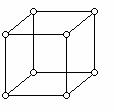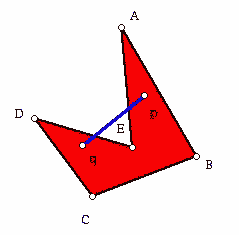Cubes
3. The 3-dimensional cube
Everyone is familiar with the 3-dimensional cube (or 3-cube for short) and its standard representation on a flat piece of paper. Note that in the diagram below there are two places where edges of the cube cross but where there is no "circular dot," which is the symbol reserved for the vertex of a graph (polyhedron). The lack of a circular dot indicates that this crossing of the edges of the cube is an "accidental" consequence of drawing something in 2 dimensions that "lives" in 3 dimensions.

The cube is an example of a polyhedron, a surface made up of pieces of planes. Planes are important because they are flat surfaces rather than curved surfaces. The algebraic equations of planes, or hyperplanes as their higher dimensional analogues are called, involve only the first power of the variables used in describing them. The cube is one of the earliest polyhedra studied for its mathematical properties. It appears in Euclid's Elements as one of the 5 regular polyhedra. Although the pyramids of Egypt look polyhedral from a distance, their faces are not really very flat up close. Furthermore, the Egyptians do not seem to have singled out the collection of regular polyhedra as did the Greeks. Strictly speaking, the treatment of regularity by Greek geometers was not accurate due to the failure of being explicit that only convex polygons and polyhedra were being considered.
Here is a brief review of the relevant ideas. A regular polyhedron is one which consists of congruent convex regular polygons, and where all of the vertices of the polyhedra are congruent (alike) as well. Recall that a set or figure X is convex if, whenever p and q are points of X, then all the points of a line segment joining p and q are also in X. The set X below (in red) is non-convex because the blue line from point p to point q is not completely within the set.
Loosely speaking, plane sets fail to be convex when they have notches or holes. It is sometimes convenient to be able to "convexify" a non-convex set in a non-ambiguous way. This is achieved by the concept of the convex hull of a set X: The intersection of all convex sets that contain X (also characterized as the smallest convex set that contains X). For the non-convex polygon above, its convex hull is shown below:
The 3-cube is familiar to us as blocks that children play with. It is also well known as the shape taken by various mathematically themed puzzles and toys (e.g. Soma cube and Rubik's cube). If you stare at the cube (Necker cube) at the beginning of this section, you will perhaps see that the face that you think is in front pops in and out. This perceptual phenomenon is well known to psychologists who have studied a variety of such phenomena in attempts to understand more fully how the human perceptual system works.
-
Introduction
-
Some history
-
The 3-dimensional cube
-
Combinatorial perspectives on cubes
-
A recursive way of constructing cubes
-
Cube puzzles
-
Symmetries of the cube
-
The Sharir-Ziegler cube
-
References
Welcome to the
Feature Column!
These web essays are designed for those who have already discovered the joys of mathematics as well as for those who may be uncomfortable with mathematics.
Read more . . .
Feature Column at a glance





